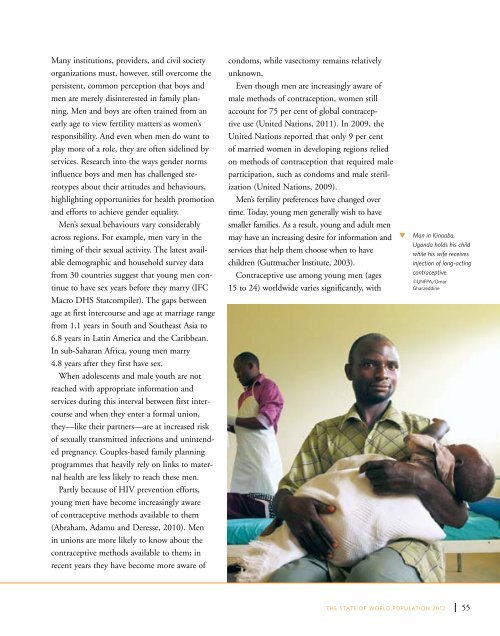State of World Population 2012 - Country Page List - UNFPA
State of World Population 2012 - Country Page List - UNFPA
State of World Population 2012 - Country Page List - UNFPA
Create successful ePaper yourself
Turn your PDF publications into a flip-book with our unique Google optimized e-Paper software.
Many institutions, providers, and civil society<br />
organizations must, however, still overcome the<br />
persistent, common perception that boys and<br />
men are merely disinterested in family planning.<br />
Men and boys are <strong>of</strong>ten trained from an<br />
early age to view fertility matters as women’s<br />
responsibility. And even when men do want to<br />
play more <strong>of</strong> a role, they are <strong>of</strong>ten sidelined by<br />
services. Research into the ways gender norms<br />
influence boys and men has challenged stereotypes<br />
about their attitudes and behaviours,<br />
highlighting opportunities for health promotion<br />
and efforts to achieve gender equality.<br />
Men’s sexual behaviours vary considerably<br />
across regions. For example, men vary in the<br />
timing <strong>of</strong> their sexual activity. The latest available<br />
demographic and household survey data<br />
from 30 countries suggest that young men continue<br />
to have sex years before they marry (IFC<br />
Macro DHS Statcompiler). The gaps between<br />
age at first intercourse and age at marriage range<br />
from 1.1 years in South and Southeast Asia to<br />
6.8 years in Latin America and the Caribbean.<br />
In sub-Saharan Africa, young men marry<br />
4.8 years after they first have sex.<br />
When adolescents and male youth are not<br />
reached with appropriate information and<br />
services during this interval between first intercourse<br />
and when they enter a formal union,<br />
they—like their partners—are at increased risk<br />
<strong>of</strong> sexually transmitted infections and unintended<br />
pregnancy. Couples-based family planning<br />
programmes that heavily rely on links to maternal<br />
health are less likely to reach these men.<br />
Partly because <strong>of</strong> HIV prevention efforts,<br />
young men have become increasingly aware<br />
<strong>of</strong> contraceptive methods available to them<br />
(Abraham, Adamu and Deresse, 2010). Men<br />
in unions are more likely to know about the<br />
contraceptive methods available to them; in<br />
recent years they have become more aware <strong>of</strong><br />
condoms, while vasectomy remains relatively<br />
unknown.<br />
Even though men are increasingly aware <strong>of</strong><br />
male methods <strong>of</strong> contraception, women still<br />
account for 75 per cent <strong>of</strong> global contraceptive<br />
use (United Nations, 2011). In 2009, the<br />
United Nations reported that only 9 per cent<br />
<strong>of</strong> married women in developing regions relied<br />
on methods <strong>of</strong> contraception that required male<br />
participation, such as condoms and male sterilization<br />
(United Nations, 2009).<br />
Men’s fertility preferences have changed over<br />
time. Today, young men generally wish to have<br />
smaller families. As a result, young and adult men<br />
may have an increasing desire for information and<br />
services that help them choose when to have<br />
children (Guttmacher Institute, 2003).<br />
Contraceptive use among young men (ages<br />
15 to 24) worldwide varies significantly, with<br />
t<br />
Man in Kinaaba,<br />
Uganda holds his child<br />
while his wife receives<br />
injection <strong>of</strong> long-acting<br />
contraceptive.<br />
©<strong>UNFPA</strong>/Omar<br />
Gharzeddine<br />
THE STATE OF WORLD POPULATION <strong>2012</strong><br />
55
















